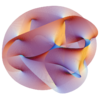Superconformal algebra
In theoretical physics, the superconformal algebra is a graded Lie algebra or superalgebra that combines the conformal algebra and supersymmetry. In two dimensions, the superconformal algebra is infinite-dimensional. In higher dimensions, superconformal algebras are finite-dimensional and generate the superconformal group (in two Euclidean dimensions, the Lie superalgebra does not generate any Lie supergroup).
Superconformal algebra in dimension greater than 2
The conformal group of the [math]\displaystyle{ (p+q) }[/math]-dimensional space [math]\displaystyle{ \mathbb{R}^{p,q} }[/math] is [math]\displaystyle{ SO(p+1,q+1) }[/math] and its Lie algebra is [math]\displaystyle{ \mathfrak{so}(p+1,q+1) }[/math]. The superconformal algebra is a Lie superalgebra containing the bosonic factor [math]\displaystyle{ \mathfrak{so}(p+1,q+1) }[/math] and whose odd generators transform in spinor representations of [math]\displaystyle{ \mathfrak{so}(p+1,q+1) }[/math]. Given Kac's classification of finite-dimensional simple Lie superalgebras, this can only happen for small values of [math]\displaystyle{ p }[/math] and [math]\displaystyle{ q }[/math]. A (possibly incomplete) list is
- [math]\displaystyle{ \mathfrak{osp}^*(2N|2,2) }[/math] in 3+0D thanks to [math]\displaystyle{ \mathfrak{usp}(2,2)\simeq\mathfrak{so}(4,1) }[/math];
- [math]\displaystyle{ \mathfrak{osp}(N|4) }[/math] in 2+1D thanks to [math]\displaystyle{ \mathfrak{sp}(4,\mathbb{R})\simeq\mathfrak{so}(3,2) }[/math];
- [math]\displaystyle{ \mathfrak{su}^*(2N|4) }[/math] in 4+0D thanks to [math]\displaystyle{ \mathfrak{su}^*(4)\simeq\mathfrak{so}(5,1) }[/math];
- [math]\displaystyle{ \mathfrak{su}(2,2|N) }[/math] in 3+1D thanks to [math]\displaystyle{ \mathfrak{su}(2,2)\simeq\mathfrak{so}(4,2) }[/math];
- [math]\displaystyle{ \mathfrak{sl}(4|N) }[/math] in 2+2D thanks to [math]\displaystyle{ \mathfrak{sl}(4,\mathbb{R})\simeq\mathfrak{so}(3,3) }[/math];
- real forms of [math]\displaystyle{ F(4) }[/math] in five dimensions
- [math]\displaystyle{ \mathfrak{osp}(8^*|2N) }[/math] in 5+1D, thanks to the fact that spinor and fundamental representations of [math]\displaystyle{ \mathfrak{so}(8,\mathbb{C}) }[/math] are mapped to each other by outer automorphisms.
Superconformal algebra in 3+1D
According to [1][2] the superconformal algebra with [math]\displaystyle{ \mathcal{N} }[/math] supersymmetries in 3+1 dimensions is given by the bosonic generators [math]\displaystyle{ P_\mu }[/math], [math]\displaystyle{ D }[/math], [math]\displaystyle{ M_{\mu\nu} }[/math], [math]\displaystyle{ K_\mu }[/math], the U(1) R-symmetry [math]\displaystyle{ A }[/math], the SU(N) R-symmetry [math]\displaystyle{ T^i_j }[/math] and the fermionic generators [math]\displaystyle{ Q^{\alpha i} }[/math], [math]\displaystyle{ \overline{Q}^{\dot\alpha}_i }[/math], [math]\displaystyle{ S^\alpha_i }[/math] and [math]\displaystyle{ {\overline{S}}^{\dot\alpha i} }[/math]. Here, [math]\displaystyle{ \mu,\nu,\rho,\dots }[/math] denote spacetime indices; [math]\displaystyle{ \alpha,\beta,\dots }[/math] left-handed Weyl spinor indices; [math]\displaystyle{ \dot\alpha,\dot\beta,\dots }[/math] right-handed Weyl spinor indices; and [math]\displaystyle{ i,j,\dots }[/math] the internal R-symmetry indices.
The Lie superbrackets of the bosonic conformal algebra are given by
- [math]\displaystyle{ [M_{\mu\nu},M_{\rho\sigma}]=\eta_{\nu\rho}M_{\mu\sigma}-\eta_{\mu\rho}M_{\nu\sigma}+\eta_{\nu\sigma}M_{\rho\mu}-\eta_{\mu\sigma}M_{\rho\nu} }[/math]
- [math]\displaystyle{ [M_{\mu\nu},P_\rho]=\eta_{\nu\rho}P_\mu-\eta_{\mu\rho}P_\nu }[/math]
- [math]\displaystyle{ [M_{\mu\nu},K_\rho]=\eta_{\nu\rho}K_\mu-\eta_{\mu\rho}K_\nu }[/math]
- [math]\displaystyle{ [M_{\mu\nu},D]=0 }[/math]
- [math]\displaystyle{ [D,P_\rho]=-P_\rho }[/math]
- [math]\displaystyle{ [D,K_\rho]=+K_\rho }[/math]
- [math]\displaystyle{ [P_\mu,K_\nu]=-2M_{\mu\nu}+2\eta_{\mu\nu}D }[/math]
- [math]\displaystyle{ [K_n,K_m]=0 }[/math]
- [math]\displaystyle{ [P_n,P_m]=0 }[/math]
where η is the Minkowski metric; while the ones for the fermionic generators are:
- [math]\displaystyle{ \left\{ Q_{\alpha i}, \overline{Q}_{\dot{\beta}}^j \right\} = 2 \delta^j_i \sigma^{\mu}_{\alpha \dot{\beta}}P_\mu }[/math]
- [math]\displaystyle{ \left\{ Q, Q \right\} = \left\{ \overline{Q}, \overline{Q} \right\} = 0 }[/math]
- [math]\displaystyle{ \left\{ S_{\alpha}^i, \overline{S}_{\dot{\beta}j} \right\} = 2 \delta^i_j \sigma^{\mu}_{\alpha \dot{\beta}}K_\mu }[/math]
- [math]\displaystyle{ \left\{ S, S \right\} = \left\{ \overline{S}, \overline{S} \right\} = 0 }[/math]
- [math]\displaystyle{ \left\{ Q, S \right\} = }[/math]
- [math]\displaystyle{ \left\{ Q, \overline{S} \right\} = \left\{ \overline{Q}, S \right\} = 0 }[/math]
The bosonic conformal generators do not carry any R-charges, as they commute with the R-symmetry generators:
- [math]\displaystyle{ [A,M]=[A,D]=[A,P]=[A,K]=0 }[/math]
- [math]\displaystyle{ [T,M]=[T,D]=[T,P]=[T,K]=0 }[/math]
But the fermionic generators do carry R-charge:
- [math]\displaystyle{ [A,Q]=-\frac{1}{2}Q }[/math]
- [math]\displaystyle{ [A,\overline{Q}]=\frac{1}{2}\overline{Q} }[/math]
- [math]\displaystyle{ [A,S]=\frac{1}{2}S }[/math]
- [math]\displaystyle{ [A,\overline{S}]=-\frac{1}{2}\overline{S} }[/math]
- [math]\displaystyle{ [T^i_j,Q_k]= - \delta^i_k Q_j }[/math]
- [math]\displaystyle{ [T^i_j,{\overline{Q}}^k]= \delta^k_j {\overline{Q}}^i }[/math]
- [math]\displaystyle{ [T^i_j,S^k]=\delta^k_j S^i }[/math]
- [math]\displaystyle{ [T^i_j,\overline{S}_k]= - \delta^i_k \overline{S}_j }[/math]
Under bosonic conformal transformations, the fermionic generators transform as:
- [math]\displaystyle{ [D,Q]=-\frac{1}{2}Q }[/math]
- [math]\displaystyle{ [D,\overline{Q}]=-\frac{1}{2}\overline{Q} }[/math]
- [math]\displaystyle{ [D,S]=\frac{1}{2}S }[/math]
- [math]\displaystyle{ [D,\overline{S}]=\frac{1}{2}\overline{S} }[/math]
- [math]\displaystyle{ [P,Q]=[P,\overline{Q}]=0 }[/math]
- [math]\displaystyle{ [K,S]=[K,\overline{S}]=0 }[/math]
Superconformal algebra in 2D
There are two possible algebras with minimal supersymmetry in two dimensions; a Neveu–Schwarz algebra and a Ramond algebra. Additional supersymmetry is possible, for instance the N = 2 superconformal algebra.
See also
References
- ↑ West, P. C. (2002). "Introduction to Rigid Supersymmetric Theories". Confinement, Duality, and Non-Perturbative Aspects of QCD. NATO Science Series: B. 368. pp. 453–476. doi:10.1007/0-306-47056-X_17. ISBN 0-306-45826-8.
- ↑ Gates, S. J.; Grisaru, Marcus T.; Rocek, M.; Siegel, W. (1983). "Superspace, or one thousand and one lessons in supersymmetry". Frontiers in Physics 58: 1–548. Bibcode: 2001hep.th....8200G.
 |


